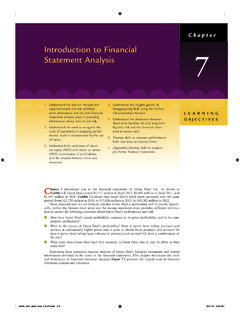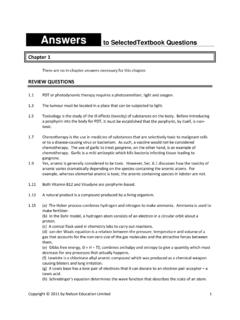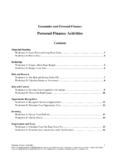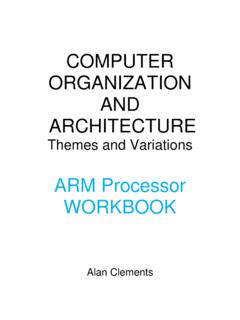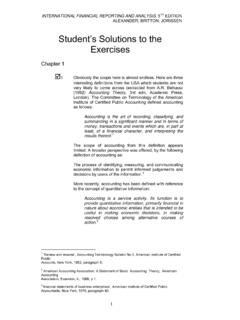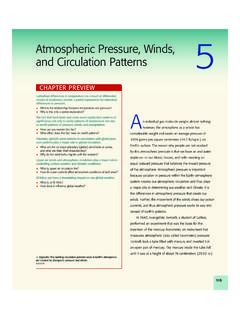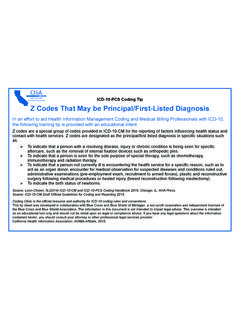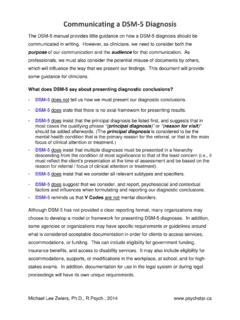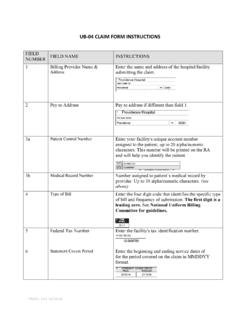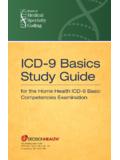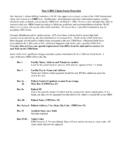Transcription of TUTORIAL How to Code an Ambulatory Surgery …
1 TUTORIAL : How to code an Ambulatory Surgery Unit (ASU) Record Welcome! Assigning ICD-10-CM codes to diagnoses as well as CPT and HCPCS Level II codes for Ambulatory Surgery records can be somewhat intimidating to students at first . No fear! I am going to walk you through this entire process, page-by-page, so you learn how to assign codes to diagnosis and procedures. You will also see where the codes are entered on a UB-04 claim, which is submitted to third-party payers for processing, resulting in reimbursement being provided to the hospital (for Ambulatory , or outpatient, Surgery ).
2 NOTE: Chapter 19 of your textbook contains content about the purpose of the UB-04, which you can review. You will also take the MEDR 4214 (Insurance and Reimbursement Processing) course in future where you will learn how to complete the CMS-1500 for each type of third-party payer. At the end of this TUTORIAL , you will also view the results of entering CPT/HCPCS level II in an Ambulatory Payment Classification (APC) calculator, which determines reimbursement provided to hospital (for Ambulatory , or outpatient, Surgery ). (To locate APC calculators and groupers, click on the Encoder Software menu item in this course and select either the 3M or the Optum360 encoder.)
3 NOTE: When entering ICD-10-CM, CPT, and HCPCS level II codes for ASU Coding Project, be sure that you have determined the Ambulatory payment classification (APC) number by using the APC calculator by logging into either the 3M encoder or the Optum360 encoder, located by clicking on the Encoder Software menu item. An example of an APC display is included at the end of this TUTORIAL , and each element of the results is explained. Before Assigning ICD-10-CM, CPT, and HCPCS Level II Codes Before coding the ASUC ases, review the following definitions.
4 Admission diagnosis the condition assigned to the patient upon admission to the facility ( , hospital outpatient department, Ambulatory Surgery center, and so on) and coded according to ICD-10-CM. first - listed diagnosis the condition treated or investigated during the relevant episode of care; coded according to ICD-10-CM. NOTE: When there is no definitive diagnosis , the first - listed diagnosis is the main symptom, abnormal findings or problem. Secondary diagnosis the condition(s) that co-exist during the relevant episode of care and affect the treatment provided to the patient; coded according to ICD-10-CM.
5 NOTE: Assign ICD-10-CM codes to secondary diagnoses only if one or more of the following are documented in the patient s record: clinical evaluation of the condition, therapeutic treatment of the condition, diagnostic procedures performed to evaluate the condition. first - listed Procedure the procedure that has the highest payment associated with it; coded according to CPT and HCPCS Level II. NOTE: Do not confuse first - listed procedure with principal procedure, which is reported for inpatient cases. Secondary Procedure the procedure(s) that are less complex than the first - listed procedure; coded according to CPT and HCPCS level II.
6 Third party payers usually discount payment of secondary procedures by 50%. NOTE: A secondary procedure that does not add significant time or complexity to the patient s care, or which is considered an integral part of the primary procedure, is called incidental procedure. Examples include an incidental appendectomy, lysis of adhesions, and scar revision. When an incidental procedure is performed, payers reimburse for the primary procedure and no payment is made for the incidental procedure (even if a CPT or HCPCS level II code is reported).
7 Admission diagnosis The admission diagnosis (or admitting diagnosis ) is the condition assigned to the patient upon admission to the facility ( , hospital outpatient department, Ambulatory Surgery center, and so on) and coded according to ICD-10-CM. The admission diagnosis is the initial diagnosis documented by the patient's surgeon who determined that Surgery was necessary: for treatment of a condition diagnosed by the patient's primary care physician (in the office), or by the patient's surgeon (in the office during a consultation visit as a second opinion), and/or for scheduled elective Surgery ( , cosmetic Surgery , such as rhinoplasty).
8 NOTE: The patient's surgeon (who is also responsible for admitting the patient to the Ambulatory Surgery unit) or his office staff contacts the facility's patient registration department to provide the admitting diagnosis . A surgeon's office staff includes medical assistants, nurses, physician assistants, nurse practitioners, and so on, any one of whom may be instructed by the surgeon to communicate the admitting diagnosis to the hospital's Ambulatory Surgery unit's patient registration department. Next, the patient registration clerk (who is employed in the hospital's patient registration department) keyboards the admitting diagnosis into admission/discharge/transfer (ADT) software.
9 That admission diagnosis (along with all other patient information) appears on the face sheet of the Ambulatory Surgery unit (ASU) record. When the patient is discharged from the Ambulatory Surgery unit of the hospital, coders assign an ICD-10-CM code to the admission diagnosis (or admitting diagnosis ). The admission diagnosis (or admitting diagnosis ) is always: located on the Ambulatory Surgery unit face sheet. assigned just one ICD-10-CM code . NOTE: Assign just one admission diagnosis (or admitting diagnosis ) code even if more than one admission diagnosis is documented on the face sheet.
10 Assign a code to the first admission diagnosis (or admitting diagnosis ) documented on the Ambulatory Surgery unit face sheet. NOTE: Although the admission diagnosis (or admitting diagnosis ) is also documented elsewhere in the patient record ( , history & physical examination, admitting progress note, short stay record), the code that is assigned to the admission diagnosis (or admitting diagnosis ) is located on the Ambulatory Surgery unit face sheet. NOTE: In "real life," the admission diagnosis (or admitting diagnosis ) documented on the Ambulatory Surgery unit face sheet may differ from the admission diagnosis (or admitting diagnosis ) that is documented by the surgeon in the history & physical examination or admitting progress note.
